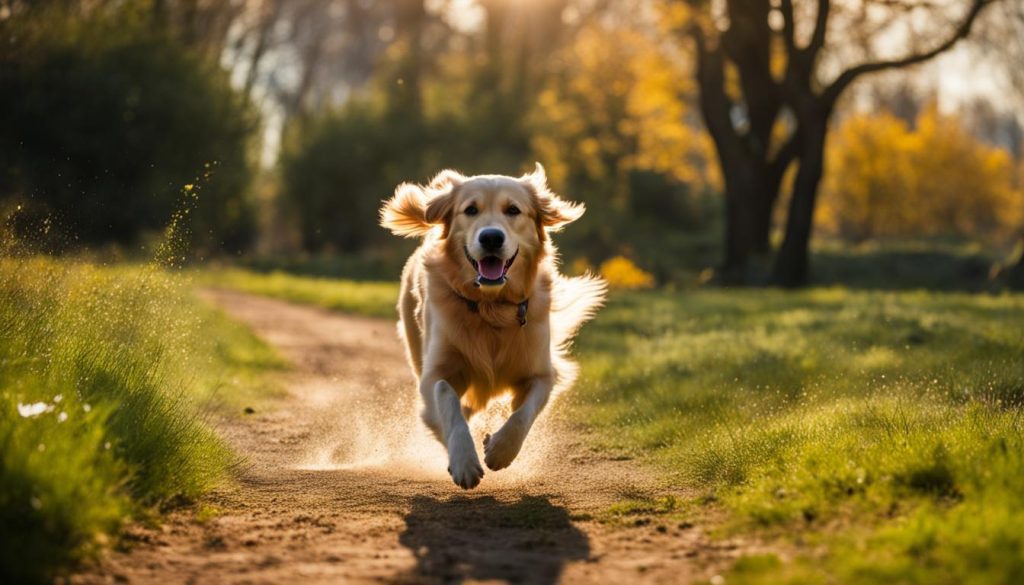As a dog owner, I know firsthand how important it is to correct dog behavior issues to ensure a harmonious and safe living environment for both the dog and the family. Correcting dog behavior problems involves an assortment of strategies such as positive reinforcement training, consistent exercise, preventing the development of bad habits, rewarding desired behaviors, and maintaining consistency in household rules.
How to Correct Dog Behavior
- Positive reinforcement training is crucial for modifying dog behavior
- Consistent exercise plays a significant role in preventing unwanted behaviors
- Preventative strategies help stop bad habits before they start
- Effective communication and household rule consistency are essential for successful training
- Immediate corrections with proper timing and technique contribute to better behavior modification
- Professional assistance may be necessary for more challenging behavior problems
Understanding Why Dogs Exhibit Unwanted Behaviors
Dogs exhibit unwanted behaviors for various reasons, including lack of exercise, boredom, inconsistency in training, and unclear communication from their owners. Unwanted behaviors such as jumping, countersurfing, and excessive barking can often be attributed to the dog not understanding what is expected of them. Providing mental and physical stimulation, along with structured dog behavior training, helps address the underlying causes of problematic behaviors.
Understanding the breed’s activity level and providing proper exercise according to the dog’s needs is also crucial. Different dog breeds have distinct energy levels, exercise requirements, and temperament. To tackle dog behavior issues, it’s essential to consider these factors when approaching behavior modification in your canine companion.
Furthermore, paying attention to your dog’s body language, vocalizations, and signals can aid in understanding the possible triggers of undesirable behaviors. For example, a dog that barks incessantly when visitors arrive may be experiencing anxiety, territorial behavior, or sheer excitement. Deciphering these signals can help guide the approach for behavior modification and better tailor it to address the specific behavioral issue.
Keep in mind that consistency plays a crucial role in correcting unwanted behaviors. Dogs thrive on routines and clear expectations. When owners are inconsistent in their training methods, dogs may become confused and unable to properly comprehend the desired behavior. By maintaining consistency and using routines throughout the training process, dogs can steadily learn what is expected of them and reduce unwanted behaviors.
Understanding why dogs exhibit unwanted behaviors is fundamental in tackling dog behavior issues. Addressing the root causes of undesirable actions through proper exercise, mental stimulation, and structured training enables owners to modify their dogs’ behavior effectively. By being consistent and understanding your pet’s individual needs and signals, you can work together to create a lasting improvement in your dog’s behavior.
1. Positive Reinforcement: The Key to Modifying Dog Behavior
Using positive reinforcement for dog behavior modification is a powerful and effective way to correct common issues in canines. This technique involves consistently praising and rewarding your dog whenever they display the desired behavior, be it lying quietly, walking nicely on a leash, or engaging in a game with you.
Proper Use of Rewards and Praise
It is essential to understand the proper use of rewards and praise for successfully implementing dog behavior modification techniques. Always use a combination of treats, verbal praise, and physical affection to reinforce the behavior you desire. For example, when your dog sits on command, offer a treat and affectionate petting coupled with enthusiastic words to let them know they did a good job. This approach helps teach your dog that following your instructions consistently leads to positive outcomes.
Shaping Behaviors with Patience and Consistency
It takes time and consistency to shape your dog’s behavior effectively. It is necessary to communicate your expectations clearly and progressively reinforce behaviors that align with these expectations. Start by introducing one command at a time, such as “sit” or “stay,” and build upon that foundation as your dog demonstrates understanding and compliance. Patiently work on providing mental engagements, such as puzzle toys and games, to keep your dog stimulated and encourage continued improvement in their behavior.
In conclusion, maintaining consistency in your approach to training with a focus on effective ways to correct dog behavior is essential for long-term success. Positive reinforcement, appropriate use of rewards and praise, along with a patient and consistent mindset, can help you promote good behavior, address issues, and strengthen the bond between you and your canine companion.
2. Setting the Stage for Success: Preventative Strategies
One of the most effective ways to ensure a well-behaved dog is by implementing preventative strategies that minimize the chances of your dog developing behavior problems. By focusing on preventing bad dog behavior, you can create a harmonious home environment for both you and your furry friend.
Puppy-Proofing to Prevent Bad Habits
In order to prevent bad habits from forming, it’s essential to create a safe and controlled environment for your dog. One way to achieve this is through puppy-proofing your home. By removing potential temptations and hazards, such as shoes, household plants, and other enticing items, you can greatly reduce the likelihood of your dog developing unwanted behaviors. Supervising your dog while they’re outside, particularly in their own yard, can also help prevent negative behaviors before they become ingrained habits.
Importance of Consistent Rules in the Household
Consistency in dog behavior training is key to teaching your dog what’s expected of them and avoiding any confusion that may contribute to bad behavior. Ensuring everyone in your household follows the same set of dog behavior rules is crucial for preventing problems. For example, if one family member allows your dog to jump up for attention while others discourage it, your dog is unlikely to learn that jumping up is an unwanted behavior.
Similarly, all household members should avoid feeding your dog from the table, as doing so only encourages begging and makes it more challenging to enforce good behavior. It’s important to communicate these rules clearly to everyone in the home and maintain consistency in their enforcement. By being consistent in your household dog behavior rules and puppy-proofing your home, you’ll be setting the stage for success in preventing dog behavior problems and raising a well-behaved canine companion.
3. Exercise: A Fundamental Element for a Well-Behaved Dog
An essential component in promoting a well-behaved dog is regular dog exercise. Physical activity helps to release pent-up energy, which, if not given an outlet, can often manifest as destructive behaviors such as chewing and leash pulling. The level of exercise a dog requires varies based on its breed and age. Therefore, it’s crucial to evaluate whether your canine companion is getting enough exercise to prevent them from channeling excess energy into bad behavior.

Appropriate energy release for dogs typically involves a healthy balance of both physical and mental stimulation. Walks, runs, and playtime help to satisfy your dog’s physical needs, while mental stimulation can be achieved through games and problem-solving exercises. Providing these activities can not only curb unwanted behaviors but also strengthen the bond between you and your dog.
Assessing your dog’s exercise requirements involves understanding the specific needs of their breed. For instance, high-energy breeds such as Border Collies and Siberian Huskies will require more exercise compared to more relaxed breeds like Bulldogs or Basset Hounds. Regularly engaging your dog in age-appropriate and breed-specific activities is critical in ensuring their overall well-being and good behavior.
In conclusion, consistent and suitable exercise plays a significant role in nurturing a well-behaved dog. It is essential to recognize and cater to your dog’s exercise requirements while providing a balanced mix of physical and mental stimulation. Supplying your dog with appropriate energy release outlets will not only keep them happy and healthy but also curb undesirable behaviors, making life more enjoyable for both you and your beloved pet.
4. Immediate Corrections: Timing and Technique
Correcting unwanted behavior in dogs involves understanding operant conditioning, which includes negative punishment (removing something the dog wants) and positive punishment (adding something displeasing). Immediate and correctly timed feedback helps the dog associate their action with the correction, leading to effective behavior modification.
Understanding Negative and Positive Punishment
Negative punishment refers to removing something a dog finds enjoyable as a consequence of displaying an undesired behavior. For example, turning away from a dog that jumps on you is an act of negative punishment, as it removes the attention they were seeking. On the other hand, positive punishment involves introducing something undesirable, like a firm, verbal “no,” when a dog exhibits unwanted behavior, such as excessive barking.
Implementing both negative and positive punishment can be highly effective in reducing undesirable behavior, provided these techniques are employed logically and within the parameters of dog behavior consequences and correction timing.
Effectiveness of Real-Time Feedback
The effectiveness of real-time feedback lies in its immediacy, which helps dogs associate the unwanted behavior with the consequence. Clear communication, consistency, and appropriate punishment leveraged in a timely manner are key in reducing the risk of repetitive, unwanted behavior. The correction process involves catching the dog in the act, delivering appropriate feedback, and following up to ensure understanding.
For example, if your dog starts to chew on a furniture item, immediately provide a stern “no,” followed by redirecting them to an appropriate chew toy. Upon switching to the designated chew toy, you could further reinforce their choice by providing praise or a treat—thereby utilizing positive reinforcement in conjunction with the real-time feedback.
In conclusion, immediate feedback in dog training is essential for effectively modifying dog’s behavior. By understanding operant conditioning, employing the right balance of negative and positive punishment, and maintaining clear communication and consistency, dog owners can successfully correct their pets’ behavior over time.
5. Addressing Common Behavioral Issues: Jumping, Barking, and More
When dealing with dog behavior issues, it’s essential to use various strategies tailored to the specific problems. Be it addressing dog jumping, excessive dog barking, or pulling on the leash, the key is being proactive and consistent in your approach.

Jumping on people is a common behavior issue in dogs. To curb this habit, teach your dog the “sit” command. When applied consistently, it helps in replacing the undesirable jumping behavior. Every time your dog attempts to jump on you or someone else, give the “sit” command. As your dog learns to be compliant, be sure to reward and praise them for sitting. Consistency is crucial; ensure everyone interacting with your dog follows the same procedure to reinforce the desired behavior effectively.
Excessive Dog Barking:
Dog barking is natural, but excessive barking can be a nuisance. The first step in addressing excessive barking is to identify the cause. Once you understand the reason, implement appropriate strategies such as teaching the “quiet” command or providing mental stimulation through interactive toys. In some cases, providing your dog adequate exercise can also help in reducing excessive barking by channeling their energy positively.
Chewing and Pulling on the Leash:
Chewing and leash pulling are additional dog behavior issues that can be addressed using targeted training techniques. For chewing, ensure your dog has access to appropriate chew toys. If they chew on undesirable objects, redirect them towards their toys and praise them when they use them. In the case of leash pulling, be consistent in reinforcing good leash behavior by stopping when your dog pulls, and praising and rewarding them for walking correctly.
In conclusion, addressing common dog behavior issues requires patience, persistence, and tailored training strategies. Focusing on replacing undesirable behaviors with desirable ones, implementing specific commands, and being consistent in your approach, will go a long way in managing these behavior problems successfully.
6. Professional Assistance: When to Seek Help from a Trainer or Behaviorist
Although many dog behavior issues can be managed with proper home training, there are instances where seeking help from a professional is necessary. When behavioral issues persist despite your best efforts, it may be time to seek professional dog behavior correction to help improve your dog’s behavior and overall well-being.
The Role of Professional Dog Behavior Correction
Engaging a qualified trainer or behaviorist can offer specialized knowledge in dog behavior correction, potentially addressing deeper issues such as aggression or separation anxiety. These professionals not only possess a deep understanding of canine behavior patterns but also have experience working with different breeds and temperaments. If you’re struggling to manage your dog’s behavior on your own, the expertise and guidance provided by a qualified professional can be invaluable to help you successfully address the problem.
Dog Behavior Therapy and Advanced Training Methods
Dog behavior therapy and advanced training methods for dogs provided by professionals can help correct more complex behavior issues. These approaches may include structured behavior modification programs and potential therapeutic interventions, tailored to the individual dog’s needs.
Such programs use a combination of evidence-based techniques and customized approaches to target specific behavioral issues and help your dog achieve lasting changes. By seeking assistance from a professional, you can ensure that your dog receives the right type of intervention and guidance to overcome their behavioral challenges, ultimately leading to a happier, more well-adjusted canine companion.
In conclusion, if you have exhausted your own efforts and your dog’s behavioral issues persist, it may be necessary to seek professional help. A skilled trainer or behaviorist can provide expert guidance and specialized interventions to address complex issues and ultimately improve your dog’s behavior and overall quality of life.
READ: How to Stop Puppies Chasing Cats: A Guide to Harmonious Pet Coexistence
In Conclusion
In summary, correcting dog behavior successfully requires a comprehensive approach that combines various strategies such as positive reinforcement, consistent rules, and exercise, along with a deeper understanding of your dog’s psychology. Utilizing effective ways to correct dog behavior and consistently following through can result in a well-behaved and content canine companion.
Immediate corrections with proper timing and technique are important when addressing undesirable behaviors. By responding promptly and effectively, you reinforce the connection between the correction and the behavior, allowing your dog to understand and modify their actions accordingly.
For some persistent or more complex issues, seeking professional help from trainers or behaviorists may be necessary. This can provide advanced dog behavior training techniques, tailored to your dog’s needs, ensuring your training efforts result in success. With dedication, commitment, and the right approach, it is possible to overcome even the most common behavioral challenges in dogs and enjoy a harmonious relationship with your furry friend.
FAQ
What is positive reinforcement in dog behavior training?
Positive reinforcement is a powerful method for modifying dog behavior. It includes praising and rewarding the dog when it displays desired behaviors, such as lying quietly or walking nicely on a leash. Using consistent, reward-based training, owners can teach their dogs that positive things happen when they comply, which in turn strengthens the bond between them and encourages good behavior.
Why is consistency important in dog behavior training?
Consistency in enforcing rules is crucial for preventing and correcting dog behavior issues. When everyone in the household adheres to the same standards, such as not feeding the dog from the table or not petting them when they jump up, the dog learns what is expected and is less likely to engage in unwanted behaviors.
How does exercise affect a dog’s behavior?
Exercise is fundamental for a well-behaved dog, serving as an outlet for their energy and preventing behaviors such as destructive chewing and leash pulling. The level of physical activity a dog needs varies by age and breed. It’s vital to assess whether a dog is getting enough exercise to deter them from channeling excess energy into bad behavior.
What is the difference between negative and positive punishment in dog training?
Correcting unwanted behavior in dogs involves understanding operant conditioning, which includes negative punishment (removing something the dog wants) and positive punishment (adding something displeasing). Immediate and correctly timed feedback helps the dog associate their action with the correction, leading to effective behavior modification.
How can I address common behavioral issues such as jumping, barking, and chewing?
Common behavioral issues such as jumping, barking, chewing, and pulling on the leash require specific strategies to address them effectively. Training commands like “sit” to prevent jumping, providing appropriate chew toys, teaching “quiet” commands to reduce barking, and reinforcing good leash behavior with rewards are all effective methods for managing these issues.
When should I seek professional help for my dog’s behavioral issues?
When behavioral issues persist despite home training efforts, it may be time to seek professional assistance. A qualified trainer or behaviorist can offer specialized knowledge in dog behavior correction, potentially addressing deeper issues such as aggression or separation anxiety.






